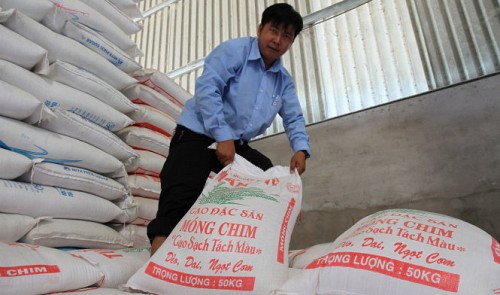
Some rice businesses in the southern province of Tien Giang have begun sourcing rice from Cambodia to distribute to Ho Chi Minh City and neighboring localities, instead of that grown in Vietnam’s Mekong Delta, known as the country’s granary.
Trung, who runs a major rice firm in the province, said he sells an average of 500 metric tons of Cambodian rice on a monthly basis.
He always comes to Cambodia to directly buy paddy there, and the rice processing and packaging are done at his own facility.
“So I can ensure competitive prices and good quality for the produce,” he said.
Many Tien Giang-based rice businesses say consumers in southern Vietnam are fond of four types of Cambodian rice, namely Sa Mo, Sa Ri, Mong Chim and Soc Mien, even though there is nothing special about their flavor and aroma.
“Cambodian rice fetches stable prices, so you do not have to worry about suffering losses,” Nguyen Thi Tim, a Tien Giang rice seller, said.
“The demand for Cambodian rice is also growing so it sells easier than the domestic grain.”
Kiet, who runs a rice-husking plant in Tien Giang, explains that the four most popular types of Cambodian rice in Vietnam are winter rice, which requires longer growing duration than the summer grain so “there are only two crops per year.”
“The short-grain Cambodian rice is less sticky when cooked, so those who do not like sticky and aromatic rice will prefer it,” he added.
His explanation is supported by Do Thi Mui, who runs two rice stores in Phan Thiet, the capital of the south-central province of Binh Thuan.
“The cooked Cambodian rice is soft and not sticky, which is easy to eat and digest, therefore largely enjoyed by local eateries and those doing heavy physical work,” Mui said.
Many eateries that sell cooked rice in Long An Province and Tien Giang admit that they can reap bigger profits by selling Cambodian rice over Vietnamese grain, as most consumers prefer soft to sticky rice.
Nguyen Thi Kieu Nga, a rice seller in Long An, also located in the Mekong Delta, said farmers usually do not use pesticide on the winter rice crops, which helps the Cambodian grain to win new customers.
Professor Vo Tong Xuan, a seasoned rice expert, confirmed that many Vietnamese consumers are eating Cambodian rice as the grain is ‘cleaner’ than that grown in Vietnam, thanks to the sparse use of insecticides.
“Many officials in the Vietnamese provinces bordering Cambodia have told me that they choose Cambodian or Thai rice for safety reasons,” he said.
“This illustrates the importance of growing rice under best practice methods such as VietGAP or GlobalGAP.
“People now eat for their health, not for a full stomach.”
Last year Vietnam exported 7.5 million metric tons, but the figure this year is expected to be only 6.7 million metric tons, according to the Ministry of Agriculture and Rural Development.
In the Jan-Oct period, the country’s rice export reached 5.03 million metric tons, according to the Vietnam Food Administration.